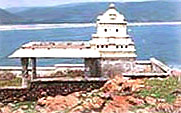 Location: Vijayawada
Location: Vijayawada
Deity: Siva or Malleswaraswami
The Malleswara temple dates to the period of Tribhuvana Malla, a Chalukyan ruler of the 10th century. Malleswara enshrines a Shivalingam and is believed to have been worshipped by sage Agastya. The deity worshipped in the temple is Mallikarjuna. The Puranas call him Malleswara. Legend states that Yudhishthira, to commemorate the victory over south, installed the idol. To this day, the idol is worshipped with a lot of devotion.
Legend: During their wanderings in the forest, the Pandavas came to Darukavana, where they met Veda Vyasa and told them to do penance to Lord Siva, to obtain the Pasupatastra. The lord pleased with penance of arjuna lord took the form of Kirata or hunter. Parvati dressed as a huntress with the Sivagana in several disguises. The wild boar came to Arjuna, being a great warrior, he shot it with a single arrow. Lord Siva also shot it with an arrow, both stuck at the same time. The boar fell dead. Both claimed the kill, and a controversy arose.
Words led to physical quarrel and they both wrestled with each other. Arjuna was no match and was soon exhausted. Even then Arjuna did not forget to worship the lord. To invoke divine favor, he made a Shivalinga out of the earth, worshipped it, and offered prayers and flowers. He saw the flowers offered to the ings before the hunter. Realising the hunter was none but the Lord. The hunter immediately disappeared and Lord Shiva appeared before Arjuna. Arjuna prayed to him and his prayer was granted, and Lord Siva gave Pasupatha to him. To commemorate this event, Arjuna installed the Vijayeswara temple on the Indrakila hill.
Architecture: The Malleswaraswami Temple is a rock cut cave temple. There is a pillar and a slab within the temple. The pillar contains inscriptions and this monument is of great historical and archaeological value, since this inscription is from the 9th century in Telugu script. It is recorded from bottom upwards. It states that a certain Thrikoti Boyi or Trikoti Boyu, the son of Kaliyama-Boy of Pechchevada, set the pillar to commemorate his fame, in order to secure distinction for his race. The Thrikoti Boyi is Guhyaka Yaksha, who in Dwaparayuga directed Arjuna to Indrakila hill on Indra`s behest.











